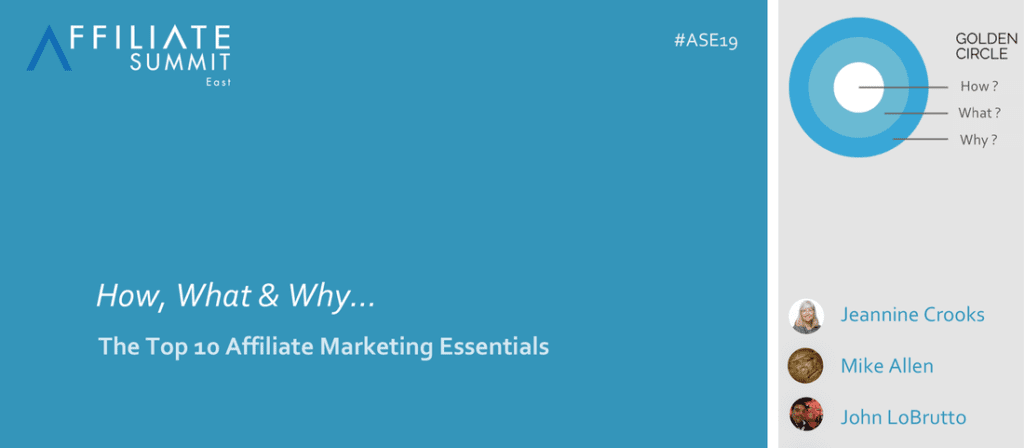On August 11, 2019, I once again had the privilege of joining Jeannine Crooks of Awin and John LoBrutto of Yes2Affiliate for a 1-hour panel at Affiliate Summit East (ASE19) in New York, NY. There we discussed “How, What & Why: The Top 10 Affiliate Marketing Essentials” and addressed ten things that we feel are essential for getting started and being successful within affiliate marketing. This panel was designed to be introductory level and affiliate/publisher-focused.
With my fellow panelists permission I’m sharing our presentation slides below. We covered the following 10 “affiliate marketing essentials”:
- How do I make money with affiliate marketing?
- What are the best practices in technology?
- How do I choose the right merchants?
- How do I work with merchants?
- How can I understand the metrics?
- Why shouldn’t I use Google Analytics?
- Why should I optimize my site?
- What is customer loyalty and why does it matter?
- Why should I get involved in the industry?
- Why I should never quit on Affiliate Marketing!
Please note that additional references and details have been included below the embedded presentation. Also, for the sake of simplicity, within this presentation we often referred to affiliate advertisers as merchants and affiliate publishers as simply affiliates.
External resources referenced on our slides
Disclosure: some links below are affiliate or referral links.
Slide 6 – Best Practices in Technology
By using WordPress, I’m recommending the free and open source version at WordPress.org for maximizing your flexibility. It can be hosted with almost any web hosting company (some hosting company recommendations further down).
WordPress plugins
The FTC requires affiliate publishers to disclose their use of affiliate links (more details here: FTC disclosure). Some plugins may help you address this need for compliance: Review Disclaimer, WP Affiliate Disclosure, and MWW Disclaimer Buttons.
Pretty Links (or ThirstyAffiliates) – highly recommended for link management. It produces a clean URL branded to your site but redirects to the affiliate link you choose. Can be quickly updated if your merchant changes affiliate networks or links. Also, PrettyLinks provides some useful analytics on clicks and usage. Free basic version.
SEO plugin recommendations: Yoast SEO or SEOPress, or RankMath (free and premium options).
WordPress themes
Selecting a speedy theme that is not bloated is essential. The Astra theme fits this model very nicely. Free and premium versions. Astra works very nicely with the Gutenberg Editor of WordPress and adds some additional formatting blocks that you can use with their Ultimate Addons for Gutenberg.
Product catalog or “datafeed” integration
Datafeedr aggregates product datafeedr from thousands of merchants and integrates beautifully into the open-source WooCommerce plugin to turn your WordPress site into one that can present products (or product comparisons, etc.). These products are sortable, searchable, and, by using Datafeedr, can be sourced from multiple merchants. Over 450 million products are available through this paid service.
Site needs
Site-wide SSL security. Recommend using a host that supports Let’s Encrypt so you can do this for free.
Use WordPress-optimized web hosting. Many budget and premium options exist; however, I’ve personally used and can easily recommend SiteGround, WPengine, LiquidWeb, and Kinsta.
Be sure to provide your customers with support. In particular, don’t forget to have a way for them to contact you (an online contact form that emails you and even a telephone number or an online chat tool – Tidio Chat has a great free option – are great options).
An “about us” page is highly recommended. Shoppers need to know that you are legitimate and trustworthy. Most like to know who they are doing business with (and even the story behind how your site came to be).
Another essential feature to include on your site is a privacy policy page (Google and many other entities also expect you to have one with details clearly spelled out). You can create a free one here (premium options available).
Other Tools
Coupon code tracking at the affiliate network level can be very useful, especially when you cannot use affiliate links (examples include some social media platforms, print media, and word of mouth venues like podcasts, videos, and personal referrals).
Affluent Analytics – track transactions across multiple affiliate networks and aggregate reporting and analytics.
FMTC (data from more than 20 affiliate networks; has about 200K affiliate links including an extensive database of coupon codes). FMTC also features some great searchable resources including their Merchant Hub with thousands of affiliate programs you can join. Be sure to check out their OPM Directory also.
Affiliate link maintenance can be a pain and almost impossible to do on a large scale. Services like Skimlinks or Sovrn //Commerce (formerly VigLink) will do this for you by automatically converting direct links to affiliate links. That way you can earn from thousands of affiliate programs without having to join each one individually. Sometimes your payout, even after their approx. 25% take, will be even higher due to tiered commission structures where they are “maxed out” due to sales from thousands of participating publishers.
Slide 14: Google Analytics
Aside from privacy concerns, there are some valid technical reasons to not trust website analytics, including Google Analytics. While probably the most reliable, server logs can be difficult to read and process. Thankfully, there are some viable solutions that allow you to keep your data and “read it” easily.
Affordable alternatives to Google Analytics you may want to consider (and I have used) include Clicky and Visitor Analytics. With them you’re paying for a service but not giving your traffic and customer data away. I also find the reporting in both of these providers much easier to read and understand compared to what I experience with Google Analytics.
Slide 19: Never Quit on Affiliate Marketing!
Don’t give up on your affiliate marketing journey. If it were easy then “everyone would be doing it” and there wouldn’t be any money to be made. Get involved within the affiliate industry. There are many affiliate resources available. Join the Performance Marketing Association and get involved within our industry. Ask questions. Contribute. Share.
In Conclusion
Be original. Be you. You’re an expert in something. Leverage that!
Don’t depend on Facebook, YouTube, Instagram, etc. to maintain your content. Once you post it there it is outside your full control. Those platforms can be considered “rented” space at best. Be sure to develop your own customer base, including email marketing and SMS or text messaging lists. (Consider using Vimeo or VooPlayer to host your own videos instead of depending on an ad-supported YouTube account that can be shut down at any time.)
It takes time to get it right. Don’t be afraid to make some mistakes, to iterate, to pivot, to adjust. Affiliate marketing is a “big pond.” There is plenty of room for all of us. Helping others is one great way to learn.
Be sure to share your suggestions, affiliate resources, and insights with others. I invite you to do so below. Thank you!




